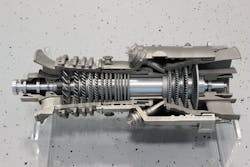Laser additive manufacturing produces true-scale gas turbine model
Full-service manufacturer H+E-Produktentwicklung (H+E; Moritzburg, Germany) and the Fraunhofer Institute for Manufacturing Technology and Advanced Materials (Fraunhofer IFAM; Dresden, Germany) worked together to develop a true-scale gas turbine that demonstrates the current potentials and limitations of powder bed-based additive manufacturing technologies. The technology demonstrator Siemens SGT6-8000 H, a model of a gas turbine for power generation on a 1:25 scale, was completely manufactured with additive processes except for the shaft.
The component assembly consists of 68 parts made of aluminum, steel, and titanium, which—through component optimization and the possibilities of electron and laser beam melting technologies—replace the almost 3000 individual parts that make up the original component. The turbine is fully functional. At the same time, the combination of conventional manufacturing technologies—in this case, machining—and additive processes with laser beam melting and selective electron beam melting is shown in one component.
Fraunhofer IFAM was involved in the manufacturing of the component as well as the data modification for the technology-adapted production. The housing components with stator stages were manufactured directly onsite at the Innovation Center Additive Manufacturing (ICAM; also in Dresden). They were produced using electron beam melting of the titanium alloy Ti-6Al-4V in the Arcam Q20plus machine, while the turbine stages and other housing components were manufactured at H+E using laser beam melting.
Related: Status of additive manufacturing for gas turbine components
The production planning was particularly important and accordingly complex to determine the right technology for each component. The accuracy and roughness of the surfaces, for example, had to be taken into account, and the necessity and number of support structures as well as the component size had to be considered. The functionality of the demonstrator was a prerequisite for all considerations. For example, the shaft and turbine stages had to be able to rotate freely between the stator stages and the individual components of the demonstrator had to be connected to each other with minimum effort—by screwing and plugging on.
The combination of different materials commercially available from the respective manufacturers is demonstrated in the component. Not all processed materials correspond to the target materials for turbines. The limitation lies in the fact that these materials cannot yet be processed in such a way that they can be offered commercially.
In the Innovation Center Additive Manufacturing ICAM, Fraunhofer IFAM has bundled its technologies in the field of additive manufacturing at one location and, therefore, can offer tailor-made solutions for a wide variety of problems from a single source.
For more information, please visit ifam.fraunhofer.de.
